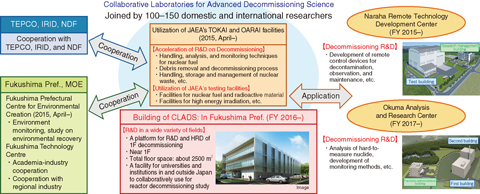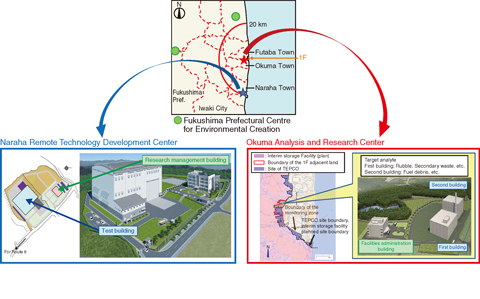
Fig.1-1 Fukushima Prefectural Centre for Environmental Creation, which will open in the FY 2015

Fig.1-2 Function of CLADS

Fig.1-3 Locations of Naraha Remote Technology Development Center and Okuma Analysis and Research Center
Contributing to the Safety and Security of Residents through Research and Development toward Environmental Recovery
To proceed with the activities lined out in the “Basic Act on Reconstruction in Response to the Great East Japan Earthquake (Cabinet Decision, July, 2012)” as well as the “Fukushima Prefectural Centre for Environmental Creation Policy for Medium- and Long-term Initiatives” formulated by the Fukushima Prefectural Centre for Environmental Creation Management Strategy Conference, we researched and developed technologies related to environmental recovery for the safety and security of residents (Fig.1-1).
We developed environmental monitoring and mapping technology capable of evaluating individual doses by monitoring living areas dose rates in forest, river, coastal, and sea areas.
We evaluated the half-lives of actual spatial dose rates under the migration behavior present in the actual environment through means such as artificial impact assessment while excluding the impact of the physical decay of radioactive cesium (Cs). This collective evaluation method is known as determining the “ecological half-life of Cs”. We assessed the dose rate changes under different land uses by utilizing the simulation model considering this ecological half-life (Topic 1-1). We have developed an analytical method to evaluate the exposure dose due to radioactive Cs deposited over a wide range of soils by the accident at the Fukushima Daiichi Nuclear Power Station (1F) of Tokyo Electric Power Company, Incorporated (Topic 1-2).
Each municipality asks for the release of the government’s evacuation order, and promotes the return of evacuated residents. The JAEA obtains technical information by studying environmental assessments and provides this information as needed for the release of evacuation orders upon municipalities. The technical information is obtained by studying a long-term assessment of the transport of radioactive contaminants in the environment of Fukushima.
Lichen is an index of radioactive Cs because it is a simple, slow-growing plant that typically forms a low, crust-like, leaf-like, or branching growth on rocks, walls, and trees. Slow-growing plants contain radioactive Cs over the long-term. Thus, we research the Cs concentration of lichen as a radioactive index of the accident at 1F (Topic 1-3). Radioactive strontium has a low concentration in fresh water. To accurately measure the radioactivity, it is necessary to concentrate the large-volume (over 100ℓ) water samples . We have found an efficient analytical method, which will help in providing detailed exposure assessment and environmental monitoring of radionuclide migration(Topic 1-4). Furthermore, to understand the 1F accident’s effect on the marine environment in detail, we measured the concentration of radioactive materials in the seabed soil taken on the Ibaraki Prefecture coast (Topic 1-5).
To contribute to reducing the burden related to the storing of soil generated from the decontamination, we studied the transition mechanisms of radioactive Cs in soil and used these mechanisms to reasonably reduce the volume of Cs-contaminated soil or to reuse the soil (Topic 1-5). A decontamination activities support system (called RESET: Restoration Support System for the Environment) was developed for the purpose of supporting the implementation of efficient and effective decontamination procedures. RESET is used in decontamination planning by national and local governments (Topic 1-6). Cs in the soil is mainly strongly adsorbed by mica such as that present in clay minerals. In separating the Cs from the mica clay mineral, it is possible to reduce the volume of the waste soil that occurs in decontamination. Using the computational science technique called a first-principles calculation method, we clarified the form of adsorption (Topic 1-7). We found that vermiculite, a clay mineral distributed widely in Fukushima, was easily adsorbed to radioactive Cs. Thus, we observed a mechanism for Cs adsorption in this mineral at the nanometer level (Topic 1-8). A large amount of sewage sludge incineration ash, contaminated with radioactive Cs, was generated. For appropriate treatment, we examined how to reduce the volume of sludge incineration ash (Topic 1-9).
The Challenge of Decommissioning
JAEA has constructed international R&D centers to integrally promote R&D and human resource development (HRD) by industry, academia, and government, forming an interacting human resource network of universities, research institutions, and industries at home and abroad. In particular, JAEA has established “Collaborative Laboratories for Advanced Decommissioning Science (CLADS)” in April 2015 for R&D towards decommissioning (Fig.1-2). The objectives of CLADS include the following: “Gathering the wisdom of experts from home and abroad”; “Enhancement of support for domestic and overseas decommissioning research”; “Enhancement of middle- and long-term HRD”; and “(performing a) Role of information transmission”. It is charged with a role of a core of R&D for the decommissioning reactors. Although JAEA is utilizing existing facilities in the Tokai and Oarai area for the time being, it will launch other collaborative research projects based on R&D facilities in Fukushima, such as the “Naraha Remote Technology Development Center (FY 2015-)” and the “Okuma Analysis and Research Center (FY 2017-)”. JAEA will develop an “International Collaborative Research Building (tentative)” in Fukushima Prefecture as the base institute utilized by many diverse researchers. This institute is to be used as a platform for basic R&D and cooperation at the 1F site with universities for HRD.
Pool Fuel and Debris-Unloading Preparation
Because a great deal of seawater was poured into the reactor to cool used fuel following the 1F accident, there is a fear that the constituent materials of a fuel aggregate will be corroded. We study soundness about strength and corrosion to storage the used fuel in common pool (Topics 1-10 and 1-11).
For safely removing fuel debris from the nuclear reactor, it is very important to know the state of the debris. This information must be known beforehand, so that removing tools or equipment can be correctly selected. We tested to determine the differences in the fuel hardness according to changes in the components of the cladding (Topic 1-12) and the extended period immersion in cooling water in a nuclear reactor (Topic 1-13).
Accident Progress Evaluation
To understand in detail how the core meltdown progressed, we performed analyses and experiments to study the fracture process and damage to the pressure vessel damage by the lower parts of the fuel rods at the time of the accident. (Topics 1-14, 1-15, 1-16, and 1-17). In addition, we evaluated the properties of the radioactive material that was released during the accident (Topic 1-18).
Processing and Disposal of Radioactive Waste
The safe storage, processing, and disposal of waste generated by the 1F accident is a very important initiative, and we need to know the states of the waste generated by the accident. At present, it is difficult to obtain samples and analyze all of the wastes; thus, data is not uniformly accurate. However, we have investigated a method of estimating the radioactivity by indirect analysis (Topic 1-19). It is well-known that hydrogen is generated by radiolysis in high-radiation moisture waste; we experimentally evaluate the amount of generated hydrogen (Topic 1-20). The result shows that it is safe to store these wastes.
The Fukushima Research Infrastructural Creation Center is now establishing two research bases for technological development toward the decommissioning of 1F. These bases are to assume roles in the preparation of removal of fuel debris from nuclear reactors and in the treatment and disposal of radioactive wastes generated from the decommissioning work. As Fig.1-3 shows, the “Remote-controlled Equipment and Device Development Facility” (hereafter, Naraha Remote Technology Development Center) is being constructed in the Naraha Town, in Fukushima Prefecture, and the “Radioactive Material Analysis and Research Facility” (hereafter, Okuma Analysis and Research Center) is being constructed in the Okuma Town, also in Fukushima Prefecture. Their outlines and situations are described below.
Naraha Remote Technology Development Center
A research management building is intended for administrative work and meetings as well as development and installation of an immersive virtual reality (VR) system. The VR system will provide a virtual reality space in which we can check the feasibility of the planned procedure and train workers and operators of remote-controlled equipment by simulating motions in places that cannot safely be accessed by humans. In the First Building, development and demonstration of new technologies such as techniques for stopping water leaks at the lower part of the reactor containment vessel, and the remote-controlled equipment necessary for investigation and decontamination in the 1F building, will be conducted. Installation of the equipment is almost complete, and all preparations for starting operation in FY 2016 will be ready soon.
Okuma Analysis and Research Center
For disposal and treatment of radioactive wastes in 1F, isotropic composition and physical property analysis of radioactive materials, safety evaluation of radioactive wastes storage, tests of radioactive waste conditioning, and technologies for safety-evaluation of disposal are needed. Some efforts such as establishing an advisory commission with outside experts have been accelerated, keeping in mind the points listed below.
• Simultaneous execution of routine work and R&D for analysis;
• Flexibility for various tests;
• Promotion of facility utilization;
• Quickness and high reliability of measurement and evaluation.
Now, we are steadily designing the Okuma Analysis and Research Center, with a view to scheduling a “Mid-and-long-Term Roadmap toward the Decommissioning of 1F”.
The Goal of the Research Base
To concentrate domestic and world expertise, our research base aims to organically actuate R&D resources. Domestically, we promote the construction of an innovation hub that realizes cooperation with universities and industry. Internationally, we have signed a memorandum with Texas A&M University for future cooperation in the demonstration of remote-control equipment, as well as a cooperative agreement that provides for international network and facility use. This is the sole research base located within 20 km off 1F. By conducting R&D and delivering results, we aim to establish an attractive research base and promote the use of facilities, and by so doing, contribute to the re-creation of regional industry.
<Previous: About This Publication and the Outline of the Organization of JAEA | Next: 1-1 >